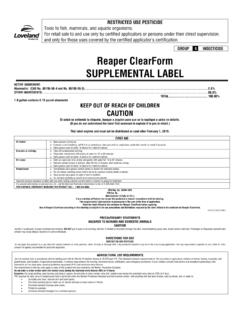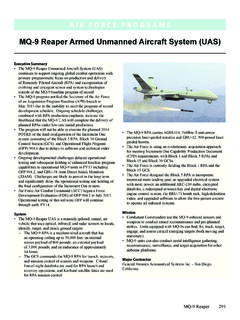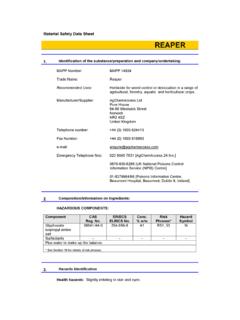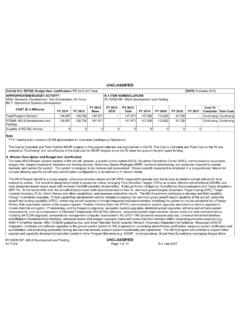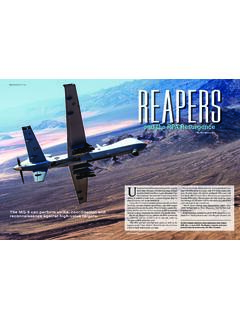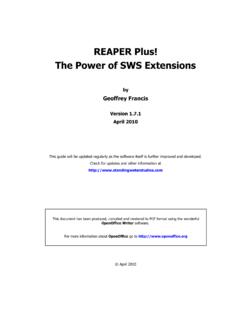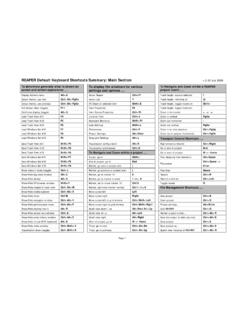Transcription of RQ-1 Predator/MQ-9 Reaper - tealgroup.com
1 World Missiles & UAVs Briefing Teal Group Corporation RQ-1 Predator/MQ-9 Reaper Unmanned Aerial Vehicles June 2019 Program BriefingThe RQ-1A Predator was the US Air Force s first medium endurance UAV. The Predator stemmed from the CIA's earlier Tier 1 Medium En-durance Unmanned Aerial Vehicle (MAE-UAV) that was deployed for surveillance missions over the for-mer Yugoslavia in 1993-94. It was based on the General Atomics Gnat 750 air vehicle. The upgraded version, the Gnat-750-TE Predator won the DoD s Tier 2 competition with a development award in January 1994 and in 1997 was redesignated as the RQ-1A Pred-ator. The Predator was first deployed over Bosnia in the summer of 1995. The US Air Force assumed opera-tional control of the Predator on 2 September 1996. The armed version of the RQ-1 Predator is designated as the MQ-1B Predator A The first series production con-tract was awarded to General Atom-ics on 20 August 1997. The US Air Force had a requirement for 12 sys-tems and 101 air vehicles, but this number steadily increased and to-taled 320 through FY10.
2 General Atomics delivered its 100th Predator on 5 February 2004. In 2007, the Air force reported it had lost about 49 of 90 operational Predators due to com-bat and accidents. In 2009, the Air Force announced plans to terminate MQ-1 Predator acquisition in favor of switching entirely to the MQ-9 Reaper . The final MQ-1 Predator was delivered to the Air Force on 3 March 2011 with about 320 delivered. Pro-duction of the Predator A ended in early 2016 after delivery of two Ital-ian aircraft. The US Air Force in 2016 announced that the last of the MQ-1 Predator force would be re-tired by 2018. A new version of the Predator was announced in 2000, the Predator-B which was first acquired by NASA for research purposes. In its hunter-killer version for the Air Force, it is designated as the MQ-9A Reaper . The Air Force had been acquiring the MQ-9A alongside the MQ-1A Pred-ator but in 2009 decided to shift en-tirely to the Reaper . Procurement through FY11 was 130 air vehicles.
3 Under the FY19 budget plan, the USAF objective is 433 aircraft with new procurement continuing through FY23. The US Army awarded a contract in May 2003 for 3 IGNAT UAVs based on the Predator to help define its UAV requirements for a divi-sional/corps level UAV called the Extended Range Multipurpose UAV (ERMP). A Predator derivative called MQ-1C Grey Eagle (formerly Sky Warrior) won the Army ERMP competition in 2005 against the Hunter II, a derivative of the Israeli Heron. The Army plans to acquire 233 air vehicles through FY20. The US Marine Corps in 2018 de-cided to begin to acquire the MQ-9 Reaper based on experiences in the use of USAF aircraft in Afghanistan. A total of 9 are expected to be funded in 2020-2022. Italy became the first export cus-tomer for Predator. Britain leased and borrowed Predators for operations in Iraq in early 2004 and in 2006 or-dered two air vehicles, followed by an order for the RQ-9 Reaper in 2007 with plans to deploy two squadrons; further orders were made in 2016 un-der the Protector program.
4 France be-gan acquiring the Reaper in 2013. The Predator is a contender in a vari-ety of foreign competitions; the Netherlands and Spain have been cleared for sales. General Atomics has developed the Predator-XP ex-port variant to make it more suitable for export and likely candidates in-clude the UAE and Saudi Arabia. General Atomics and Lockheed Martin teamed to offer a derivative of the Predator called the Mariner ( Predator B-ER) as a contender for the US Navy s BAMS (Broad Area Mission Surveillance) require-ment but it lost to the Global Hawk in April Predator-B version was selected by NASA s Earth Sci-ence Enterprise for research applica-tions as the Altair and first flew in June 2003; it was the first civil UAV to win an FAA airworthiness certifi-cate which facilitates its use in na-tional airspace. The Predator is also used by the Border Patrol with eight in service by 2012. General Atomics has developed a jet-powered deriva-tive of the Predator, called Predator C and Avenger, for the USAF MQ-X Next Generation UAS program and a navalized version called Sea Avenger for the US Navy UCLASS/ CBARS requirement (see MQ-25 Stingray report).
5 The US Air Force began acquiring small numbers of this version in 2011. General Atom-ics has also proposed an extended-range version of Reaper . RQ-1 Predator/MQ-9 Reaper Page 2 World Missiles & UAVs Briefing Teal Group Corporation Executive Big Safari Program Office Aeronautical Systems Center Air Force Materiel Command Wright Patterson AFB, OH The Tier 1 element of this program was managed by the Central Intelligence Agency. Manufacturer General Atomics Aeronautical Systems Div. PO Box 85608 San Diego, CA 92186-9784 tel: (619) 455-4649 Variants RQ-1A Predator This is the desig-nation for the baseline system, in-cluding the RQ-1K air vehicle. DERF funding from FY02 is being used to reconfigure all RQ-1A sys-tems into the MQ-1B configuration. RQ-1B Predator This is the Block 1 system using the improved RQ-1L air vehicle. MQ-1B Predator This is the up-graded RQ-1B system which enables the air vehicle to employ the Hellfire missile. MQ-1C Warrior Block 0 This is the Army version of the Predator, in-troduced as a stop gap in 2007 before the baseline Block 1 was available.
6 It has many of the same features as the Block 1 but uses the USAF/General Atomics GCS rather than the AAI One System GCS, uses a C-band data-link instead of the faster high data rate Tactical Common Data-Link, lacks the automatic landing system and some other features. MQ-1C Grey Eagle Block 1 This is the baseline Army version of the Predator and first flew in December 2007. This Predator variant for the Army uses the AAI One System as its GCS. Each system includes 12 air vehicles, five GCS and associated equipment. MQ-1C Improved Grey Eagle This is the upgraded version first flown in July 2013 with 50% more fuel capacity and powered by a Ly-coming DEL-120 diesel. RQ-1K Block 5 Predator This is the baseline version of the UAV used in the reconnaissance role. MQ-1L Predator Block 10 This is the upgraded version of the RQ-1K Block 5 modified to carry and launch the Hellfire missile in the hunter-killer role. This was officially ac-cepted for service use in February 2005 several years after having actu-ally gone into action.
7 The initial pro-duction standard was called Block 5 which remained in production through 2003 when the FY02 aircraft shifted to Block 10 configuration. The Block 20 configuration intro-duces wingtip extensions for better hot/high operations. MQ-9A Reaper Spiral 0 Formerly Predator-B, this is the enlarged ver-sion of the UAV and the baseline ver-sion of the new type. MQ-9A Reaper Spiral 1 This is version integrated the Hellfire mis-sile system on the platform. MQ-9A Reaper Spiral 2 This is the improved version with higher gross weight, redundant flight avion-ics, digitally controlled engine, sen-sor and stores management com-puter, MIL-STD-1760 data bus and improved human-machine interface. Subsystems Launch System Launcher The Gnat-750 uses conventional aircraft-style launch and landing. Launch uses a conventional under-carriage. Up to 1997, the Predator had a mean time between crashes of 1,500 to 1,700 flight hours. A study conducted in 1996 by Si-erra Nevada Corp.
8 Concluded that the Predator could be integrated into the UAV Common Automatic Recovery System (U-CARS). General Atomic completed a three-year study of the electro-magnetic aircraft launch sys-tem (EMALS) for potential use to RQ-1 Predator/MQ-9 Reaper Page 3 World Missiles & UAVs Briefing Teal Group Corporation launch the Predator from aircraft car-riers. The Predator/ Reaper takes off and lands from a runway like a conven-tional aircraft. A Predator system in-cludes one Ground Control Station (GCS), four air vehicles, a Trojan Sprit II communications suite and 635 personnel. Electronics Sensors The Tier 1 Gnat-750 is remotely piloted with several options. The UAV can be preprogrammed for au-tonomous operations and can incor-porate a GPS/INS option for im-proved accuracy. The datalink for flight control is a C-band, frequency selectable system with an optional digital video channel. The data link antenna on the Tier 1 was located in a tear-drop-shaped pod over the fuse-lage, developed by a team of Questech, General Atomics and GEC-Marconi on the basis of a $ million US Army contract.
9 The Army as part of the Joint Precision Strike program first successfully tested this system during a one-hour demonstra-tion on 2 December 1993. The data was passed, via a manned relay air-craft, from the El Mirage, CA test site to the Pentagon. The uplink antenna is housed in a dorsal pod. This served as the basis for the system on the Tier 2. During operations over Yugosla-via in 1994, the CIA used a RG-8 two-man powered glider as a data re-lay station when the UAV was be-yond line of sight. The Predator B uses a C-band antenna for line-of-sight connections to the ground con-trol station and a Ku-band satellite uplink for over-the-horizon control, and L-3 Communications of Rancho Bernardo is the supplier of the RQ-1W PPSL (Predator Primary Satellite Link). EMS Technologies provides the Ku-band CDL switch network. The RQ-1A Predator Tactical Endurance UAV system includes EO IR and GFP-SAR sensor capabilities and UHF and GFP Ku-band satellite communications. The Predator em-ploys a Litton inertial naviga-tion/GPS system for guidance.
10 The Predator has a sensor payload of 450 lb. The Skyball electro-optical pay-load includes a 14TS imaging infra-red camera and daylight camera pro-vided by Versatron/Wescam. The four of the original MQ-1B Predator hunter-killers were fitted with the AN/AAS-44 Kosovo Ball , an E/O sensor package with integral laser rangefinder in June 1999. Alt-hough some consideration was given to fitting the remainder of the RQ-1 fleet with this, instead, the plan was to use the Raytheon AN/AAS-52 multi-spectral targeting system (MTS-A) on all MQ-1B Predators, and Raytheon has also developed the improved MTS-B The initial Westinghouse syn-thetic aperture radar (SAR) was not fitted until 1995; it is nose mounted and is stabilized in two axes. This SAR has a 10- to 50-degree field of view in elevation and 150 degrees in azimuth; it has a one-foot resolution and covers an 8,000-foot swath of terrain from an altitude of 25,000 feet. The US Army Night Vision Lab was handling management of the SAR sensor.





